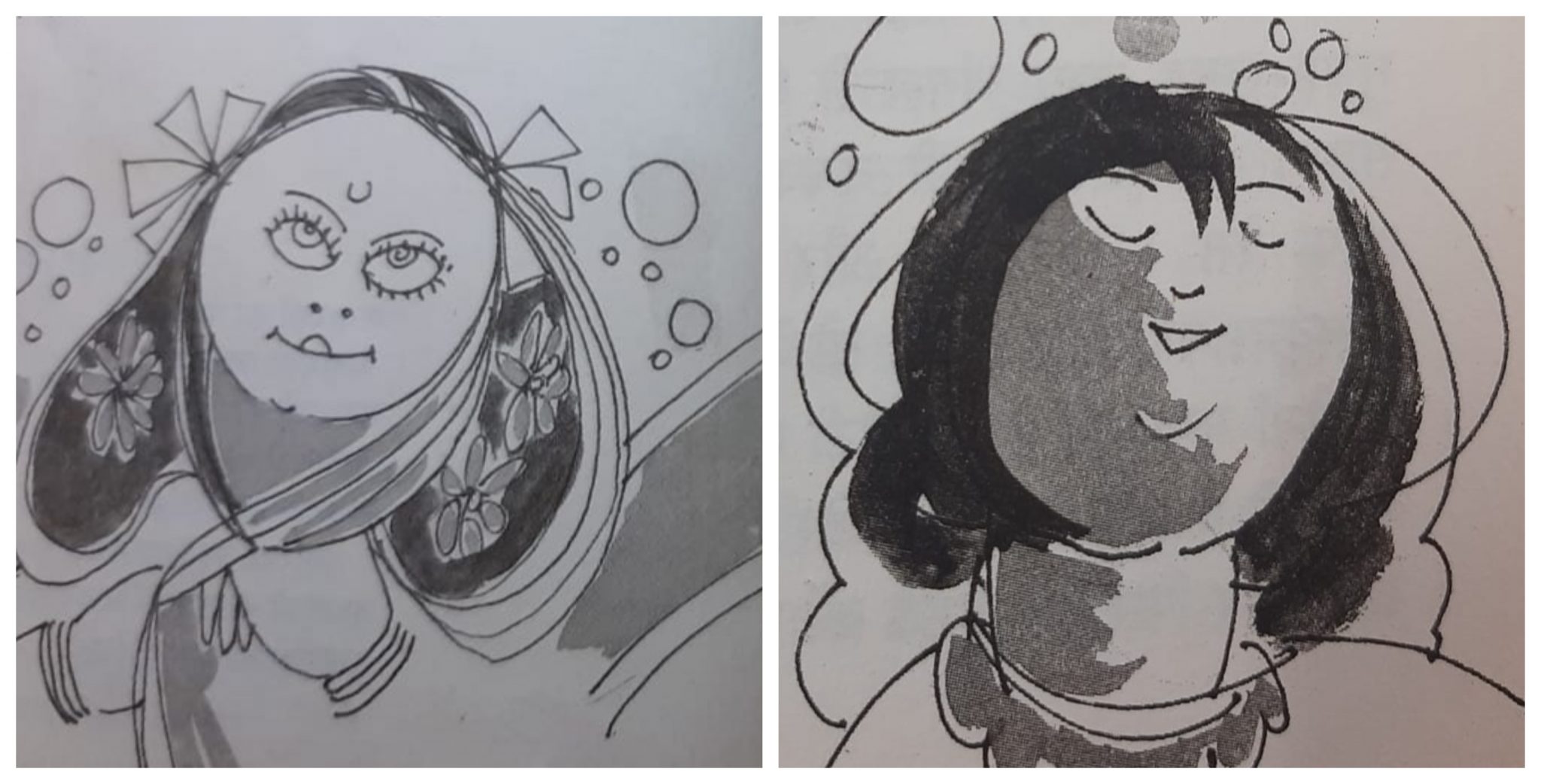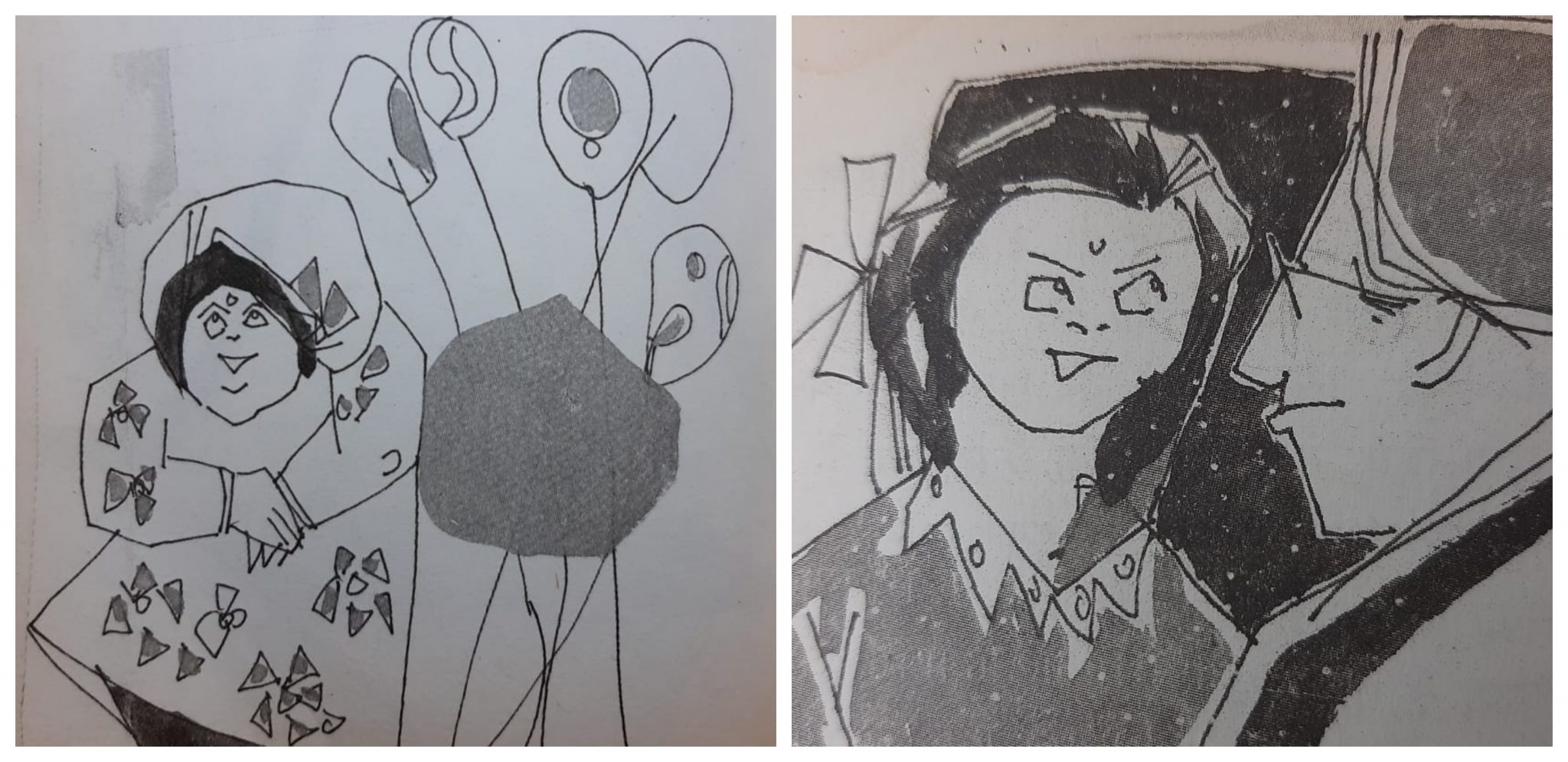Anarko ke Aath Din is a fictional story written by Satyu, illustrated by Chanchal and published by Rajkamal Prakashan Private Limited, New Delhi.
Anarko, the main character is around 9-10 years old and lives with her parents. They have certain expectations of her in terms of what she should and should not do, which she questions throughout the book. These expectations do not come from just her parents, but also from teachers and other people around her.
The book is divided into 8 chapters. Each chapter talks about Anarko’s imagination and what she thinks about different things like schooling and its importance, belief in god, parents’ belief in children and her friendship with Kinku. Kinku is Anarko’s friend with whom she wanders and experiences the world around her. This book is written from a child’s perspective, and the language and the way in which Anarko’s journey is represented makes it a simple read for parents, teachers and library educators.
I read this book when I was doing a Masters in Education and it was gifted to me by my friend who calls me ‘Anarko’. I used to wonder why I was being called Anarko. “Who is Anarko? What is common between Anarko and me?” When I read the book, I connected with Anarko in every chapter. I was often labelled a ‘rebel child’ in school and at home. Everyone knew that if they said something to me, I would not take it as it is. I would have questions, concerns which may not be answered, but I would not stop myself from asking these. I also used to hear that girls should not ask too many questions, but that only made me even more curious to know further. What is so gendered about asking questions? The questions that Anarko asks in the story are common questions that most children ask, but only a few parents, teachers and community members encourage it. Each chapter in the book shows the resilience that Anarko has, which may also inspire the readers to think about their actions and what they do when children ask questions.
The simple day-to-day discussions that Anarko has with her family, friends and school teachers bring out deep issues which are generally ignored and practices that are being followed, often without any thinking. Anarko challenges the notion that children’s minds are tabula rasa (blank slates) and that they can’t think beyond a point. Rather, Anarko’s critical thinking and her questions leaves her parents and teachers struggling for answers, often resulting in them dismissing the questions she is raising.
On day 2 of the story, Anarko says to her father, “पापा मैं आज स्कूल नहीं जाऊँगी” Her father says “स्कूल नहीं जाएगी तो विद्या कहाँ से आएगी?” To which Anarko says“विद्या मिल जाने से मैं क्या करूंगी? विद्या क्या सिर्फ स्कूल से ही आती है?” Anarko is questioning the notion of schooling and where knowledge can be acquired. As her curiosity to explore things in a ‘natural’ way is not welcomed by her teacher in school, she is often sent out of the classroom, which gives her more opportunities to dive deep into her imagination and look at the world differently. As she experiences each day, she also points out to something crucial about the thinking that comes when the mind is free and makes the reader think about it.
On the 5th day, when her mother forces her to prepare for an examination, she questions the relevance of the examination as she says it just declares who passes or fails, and does not really test a person’s knowledge. This is a part of their conversation, अम्मी:“सब पास हो जाएंगे और तू फेल हो जाएगी।” अनारको:“वो पास होकर करेंगे क्या?” अम्मी:“पास होते जाएंगे और उनको अच्छी नौकरी मिल जाएगी।” अनारको:“ये सब तो होगा पर वो करेंगे क्या?” अम्मी:“करेंगे क्या– खाएँगे,पिएंगे, आराम से रहेंगे, काम करेंगे,सोएँगे।” अनारको:“पर अम्मी ये सब तो मैं फेल होके भी कर सकती हूँ। कोई नहीं जनता की क्या करना है? सबको मालूम है की कुछ न कुछ करना है सो कुछ न कुछ करते रहते है।”
Her questioning and examining of the world critically, through her dreams, continues on all 8 days.
On the 7th day, Anarko through her questions brings out our blind acceptance of authority. “पापा प्रधानमंत्री क्यों आ रहे हैं?” पापा ने कहा “पुलका उदघाटन करने आ रहें है।” अनारको ने फिर पूछा, “उदघाटन क्या होता है पापा, पुल क्या प्रधान मंत्री ने बनाया है? ” पापा ने कहा, “नहीं बेटी, तूने देखातो है, पुल मजदूरों ने बनाया है, लोगों ने बनाया है।” अनारको ने धीरे से पूछा, “फिर प्रधानमंत्री क्यों आ रहे हैं उदघाटन करने?” I would say we as adults have stopped questioning authority and we end up following the instructions from leaders. But Anarko cautions us to think how much we are driven by leaders and their decision and why is it so?
This book was first published in 1994, but the things that Anarko questions in all eight chapters are so relevant and exist even today. The book dives into multiple facets of life, examining them in detail with the imagination that only a child has. It is portrayed as an innocent curiosity on the part of the child. However, the depth of the questions makes one re-examine one’s own beliefs.
This story could have been strengthened by providing a context to Anarko. She is presented as just a young curious girl. There is no background or story given to her that would allow us to connect with her. Also, the critical thinking is not part of her nurturing as her parents seem to be stopping her from that, so from where is she getting energy to go to the roots of things? However, the author has brought the holistic and natural way of looking at things through Anarko’s story. Though her ability to think has not been nurtured, Anarko goes on asking questions in each chapter. Is it possible that the conditioning that normally happens, through interaction with society, limits or discourages critical thinking? When I was growing up with my inquisitiveness about what we do and why we do it, I was being made to do/think certain things in the way that adults think is right which, while I was in school, stopped me from enquiring further. However, there needs to be more nurturing of this critical thinking, and we need more children asking these “tough questions”. Therefore, we need more stories like Anarko’s which reaffirm the importance of nurturing critical thinking among children, and we also need more parents and teachers reading them.
The book is written in Hindi and only the 2nd day in Anarko’s life is available in English therefore it leaves a large section of readers out of Anarko’s life. But there are so many books that are not available in Hindi!
In structure, the book follows a pattern. Each chapter begins with Anarko asking some questions and then going into her imaginary world where she engages with the world in her own way and in doing so, mentally arrives at a different place. Though the questions being explored in each chapter are quite different, a reader can guess after reading three chapters how each day is going to progress.
Sadly, the illustrations and layout of the book do not invite readers to pick this book unless it has been recommended by someone. In each illustration, the artist seems to have used a different style. Due to this, Anarko looks very different in each chapter, which makes it confusing for the reader to picture her in their mind while reading the story. Some illustrations also depict Anarko as an older girl, which does not match with the storyline.
This story may not be appreciated by many readers who believe that children should not ask questions and they should just follow instructions by adults. This book could bring about a change in perspective among those teachers and parents who don’t allow different or unique thinking.
At the same time, children of 12 years and above can relate to story as they may have had similar experiences. For someone who may not have similar experiences, this story can open a different way of looking at things.
The writing style will bring a smile to your face, but at the same time, it makes you pause and think about your own childhood. I invite you to read this book and other similar books like Ranu Main Kya Jaanu written by Asghar Wajahat and published by Jugnoo, and The Why Why Girl written by Mahasweta Devi and published by Tulika.
